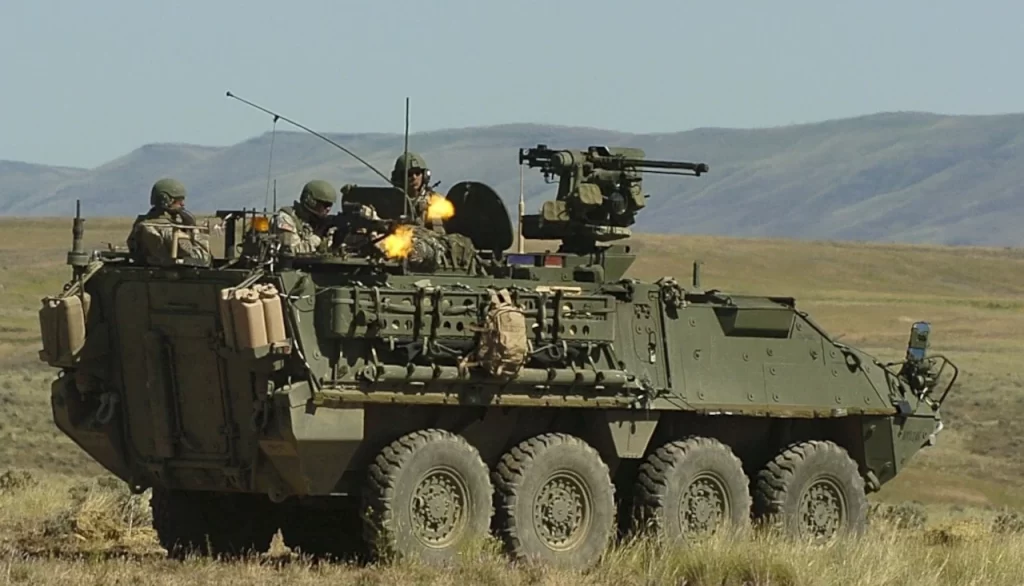On Thursday, the United States unveiled a massive $2.5 billion arms package for Ukraine, which includes 90 Stryker combat vehicles. This is the first time Washington has committed to providing this equipment to Kyiv.
The Department of Defense said that the weapons and equipment will come from Pentagon stocks, marking “the thirty-first evacuation of material from Defense Department stockpiles for Ukraine since August 2021 by the Biden administration.”
Specifically, the new arsenal includes more ammo for ground-to-air missile systems (NASAMS), eight Avenger air defence systems, 59 Bradley infantry combat vehicles, 90 Stryker armoured personnel carriers, 53 mine countermeasures vehicles, and high-mobility multipurpose wheeled vehicles (HMMWV).
In addition, the United States will provide Ukraine with additional ammunition for the HIMARS MLRS, including 20,000 155-mm artillery shells, 600 precision-guided 155-mm artillery shells, 95,000 105-mm artillery shells, 11.8 thousand 120-mm mortar shells, high-velocity anti-radar missiles (HARMs), vehicles, small arms cartridges, night vision devices, vehicle parts, and field equipment.
The United States has provided Ukraine with more than $27.4 billion “in security assistance” since the beginning of the Biden administration, more than $29.5 billion since 2014 and more than $26.7 billion since the beginning of the Russian special military operation.
The additional vehicles, together with the 50 Bradleys initially pledged to Ukraine earlier this month, will provide Ukraine with the armoured capacity of two brigades, according to the statement.
What is a Stryker Stryker armoured personnel carrier?
For a long time, the United States Army had a strange gap between infantry units, who often only had armed vehicles, and forces armed with heavier equipment like M1 Abrams tanks and M2 Bradley infantry fighting vehicles. The Stryker armoured personnel carrier, or the entire family of Stryker eight-wheeled all-wheel drive armoured vehicles, designed to bring infantry to the battlefield with its direct fire support, was deployed in the early 2000s to eliminate this gap. The US Army’s Stryker-type armoured personnel carriers are part of the family of Intermediate Armored Vehicles (IAV).

The Stryker armoured personnel carrier is a partially original invention. The design of this machine is based on the Swiss armoured personnel carrier MOWAG “Piranha” III (8 8). Strictly speaking, the Stryker armoured personnel carrier is a modified and streamlined Piranha (more precisely, its larger Canadian equivalent, LAV III) produced by the American firm General Dynamics Land Systems.
The vehicle turned out to be reasonably good and very multipurpose in every way. The fact is that the initial vehicles – both Piranha and LAV III, were large “lightly armoured minibuses” for troops and had the right weight. The Stryker’s weight greatly exceeds the load capacity of its chassis and transmission, and the vehicle’s relatively high centre of gravity contributes to its instability in off-road conditions.
The Stryker armoured personnel carrier is equipped with additional protection, a set of hinged passive protection Modular Expandable Armor System (MEXAS) and is capable of deflecting 14.5-mm heavy machine gun bullets and 30-mm cannon projectiles. However, with the installation of this 1.5-ton module, the Stryker’s weight reaches about 20 tonnes, which is excessive for an armoured personnel carrier whose base was initially designed for almost half the load.
Consequently, the vehicle, which was intended to be a “lightly armoured minibus” for infantry, was deemed too heavy to be transferred by a regular army “air truck”, C-130 “Hercules” to tactically required distances. The normal carrying capacity of the C-130 is slightly less than the weight of the “Stryker”.
The majority of the reviews from military personnel who operated the Stryker in combat conditions during the Iraq operations are positive: there is a good chance that the crew and troops would survive when the vehicle is hit, including when it is blown up by high-explosive mines. The frontal projection of a vehicle equipped with Mexas hinged passive protection (+1,700 kg) from IBD Deisenroth (Germany) is unaffected by a 30-mm armour-piercing sub-calibre round fired from 500 metres away.
The layout of the Stryker armoured personnel carrier is typical of that of other APCs; the engine is situated in the front on the right side of the vehicle when transiting in the direction of travel, the driver’s seat is situated on the left side of the vehicle, and the fighting compartment occupies the middle and rear of the vehicle.
Principal modifications to the Stryker combat platform include:
- The standard version of the Stryker M1126 ICV (Infantry Carrier Vehicle) armoured personnel carrier.
- Stryker M1127 RV (Reconnaissance Vehicle) – battlefield reconnaissance vehicle.
- Heavy weaponry combat vehicle / anti-tank self-propelled guns / wheeled tank; Stryker M1128 MGS (Mobile Gun System). Its primary armament consists of a 105 mm M68A2 cannon and a 7.62 mm coaxial machine gun housed in an expanded turret. As envisioned by the creators, “wheeled tanks” covered the activities of armoured personnel carriers; nevertheless, in actual battle situations, their doubtful combat use was a result of the enemy’s employment of anti-tank weaponry, which they were unable to resist.
- Stryker M1129 MC (Mortar Carrier) – 120 mm self-propelled mortar.
- Stryker M1130 CV (Command Vehicle) – command and staff vehicle.
- Stryker M1131 FSV (Fire Support Vehicle) – artillery fire control vehicle.
- The Stryker M1132 ESV (Engineer Support Vehicle) is the unit’s engineering vehicle.
- Stryker M1133 MEV (Medical Evacuation Vehicle) – medical evacuation vehicle.
- Stryker M1134 ATGMV (Anti-Tank Guided Missile Vehicle) is a self-propelled anti-tank missile system with a TOW-2 anti-tank missile system.
- Stryker M1135 NBCRV (Nuclear, Biological, Chemical, Reconnaissance Vehicle) – radiation, chemical and biological protection vehicle, reconnaissance for the use of weapons of mass destruction
